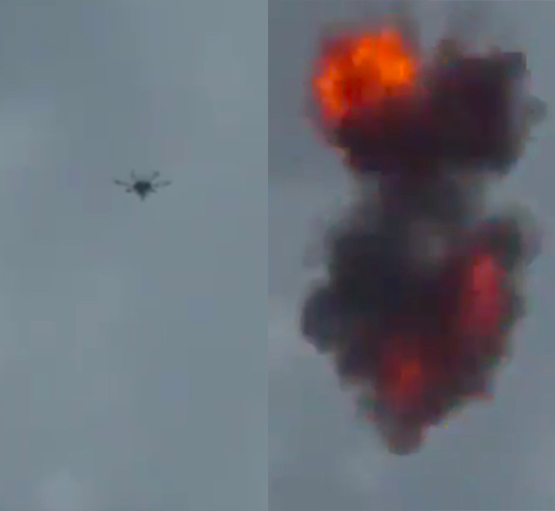Drone attack on President Maduro caught on video.
According to press reports and official reports two drones armed with explosives detonated near Venezuelan President Nicolas Maduro on Aug. 4, 2018, in an apparent assassination attempt that took place while he was delivering a speech to hundreds of soldiers, live on television.
The assailants flew two commercial drones each packed with 1 kilogram of C-4 plastic explosive toward Maduro: one of the drones was to explode above the president while the other was to detonate directly in front of him, said Interior Minister Nestor Reverol who also added the military managed to divert one of the drones off-course electronically whereas the other one crashed into apartment building two blocks away.
After a series of conflicting reports (the thruthfulness of the official claims is still debated) a video allegedly showing the detonation of the second of two commercial drones carrying explosive was published by Caracas News 24 media outlet:
Vídeo prueba del segundo drone que exploto en el aire sin causar daños colaterales #Sucesos Vídeo cortesía pic.twitter.com/ipWR2sbYvW
— Caracas News 24 🌐 (@CaracasNews24) August 5, 2018
Whilst some sources have contested the official line on the event saying the Venezuelan president might have staged the attack to purge disloyal officials and journalists, David Smilde of the Washington Office on Latin America said the amateurish attack doesn’t appear to be staged by Maduro’s government for political gain. This would confirm the one in Caracas on Aug. 4, was the first use of drone on a Head of State.
“The history of commercial drone incidents involving heads of state goes back to September 2013 when the German Chancelor Angela Merkel’s public appearance was disrupted by a drone, which was apparently a publicity stunt by a competing political party,” says Oleg Vornik, Chief Executive Officer at DroneShield, one of the companies that produce counterdrone systems, in an email. “Yesterday’s apparent drone assassination attempt on Venezuelan President Maduro is the first known drone attack on a head of state. An attempted drone assassination of a sitting sovereign leader demonstrates that, sadly, the era of drone terrorism has well and truly arrived”, Vornik comments.
Currently available counterdrone (C-UAS) systems provide early detection, analysis and identification, alerting and termination of the threatening drones by means of portable or highly mobile solutions (even though there are also C-UAS systems in fixed configuration). The drone is usually disabled by means of EW (Electronic Warfare), by disrupting multiple RF frequency bands simultaneously denying radio signals from the controller, making Live Video Feed and GPS signal unavailable to the remote operator.
Top image: composite using footage published by Caracas News 24









